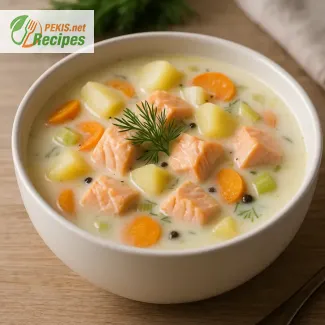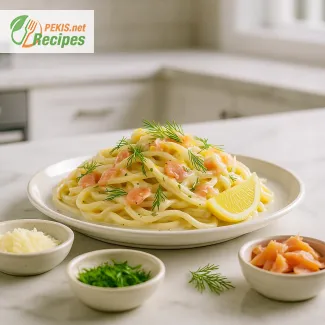
Creamy Nordic delight with fresh salmon and potatoes
A comforting Finnish classic reimagined for modern kitchens
When the weather turns crisp and the daylight hours begin to wane, there's nothing quite as satisfying as a warm, hearty bowl of Finnish salmon soup, also known as Lohikeitto. This traditional Nordic dish has long been a staple of Finnish cuisine, renowned for its simplicity, elegance, and depth of flavor. Featuring tender chunks of fresh salmon, soft potatoes, sweet carrots, and a silky cream-infused broth, Lohikeitto strikes the perfect balance between comfort and freshness.
Originating from the lakes and coastal regions of Finland, this iconic dish has become a beloved comfort food across Scandinavia. The name “Lohikeitto” directly translates to “salmon soup” in Finnish, but its rustic charm and rich yet delicate taste transcend linguistic boundaries. Over the years, it has made its way into kitchens far beyond the Nordics, with food enthusiasts around the world embracing its unique blend of flavors.
What sets Finnish salmon soup apart is its clean, natural taste that allows each ingredient to shine. The salmon, often sourced from the cold, pristine waters of the North, is the star of the show, lending the soup a buttery richness that is both nourishing and deeply satisfying. Cream adds a subtle velvety texture without overpowering the fish, while dill — the signature Nordic herb — offers a fragrant, slightly anise-like note that elevates the entire dish.
Preparing Lohikeitto at home doesn’t require special culinary skills or exotic ingredients. On the contrary, its charm lies in its simplicity. A few humble vegetables, a good piece of fresh salmon, and quality cream come together to form a deeply flavorful dish that feels luxurious and wholesome at once. The soup is usually served with rye bread or crusty sourdough, making it an ideal meal for chilly evenings, family dinners, or even elegant winter gatherings.
Unlike many cream-based soups, Finnish salmon soup is light enough to enjoy as a lunch yet filling enough to serve as a main course. Its moderate richness comes not from heavy cream or butter, but from the careful balance of root vegetables and stock. This ensures that the soup is deeply satisfying without being overly indulgent, making it a perfect choice for those who appreciate both flavor and nourishment.
A defining characteristic of Lohikeitto is its textural harmony. The vegetables are simmered until just tender, maintaining their shape and offering a gentle bite. The salmon is added only at the end, ensuring it remains moist and flaky. This layering of ingredients contributes to a dish that feels both rustic and refined.
Whether you're looking to explore the culinary traditions of Finland or simply searching for a comforting, homemade salmon soup, this recipe delivers both authenticity and ease. Its popularity continues to grow among fans of Nordic cuisine, thanks to its welcoming flavor profile and the growing global appreciation for simple, seasonal food.
For those new to Nordic cooking, Finnish salmon soup offers a perfect introduction. It showcases the foundational principles of Scandinavian cuisine: minimal ingredients, maximum taste, and respect for fresh, local produce. The use of salmon, dill, leek, and cream brings a distinctly Nordic character to the dish, making each spoonful feel like a warm embrace from the north.
As the seasons change and cravings for soul-warming meals intensify, Lohikeitto presents itself as the ideal companion. It’s the kind of dish that invites you to slow down, savor the moment, and indulge in something both familiar and new. With its harmonious blend of salmon, vegetables, and creamy broth, this Finnish classic is more than just a soup — it's a culinary experience rooted in tradition and crafted for the modern table.
- Peel the potatoes and cut them into bite-sized cubes (about 2 cm / ¾ inch). Peel and slice the carrots into thin rounds. Clean and slice the leek (white and light green parts only) into thin half-moons.
- In a large pot, bring the water to a boil. Add the potatoes, carrots, leek, bay leaf, and whole black peppercorns. Reduce the heat to medium and let simmer for 15 minutes, or until the vegetables are just tender.
- While the vegetables are cooking, cut the salmon fillet into medium-sized cubes (about 2.5 cm / 1 inch).
- Add the salmon cubes to the pot and simmer gently for 5–7 minutes, until the fish is opaque and flakes easily.
- Stir in the butter and heavy cream. Let the soup simmer for another 3–5 minutes on low heat. Do not boil to prevent the cream from curdling.
- Add salt to taste, then finely chop the fresh dill and stir it into the soup right before serving.
- Remove the bay leaf and serve hot with slices of rye bread or rustic sourdough
Elevating the Classic Lohikeitto to New Culinary Heights
Smart ingredient tweaks and cooking techniques to enhance Finnish salmon soup
Finnish salmon soup, or Lohikeitto, is celebrated for its creamy texture, rich salmon flavor, and gentle warmth. While the traditional recipe is already delicious in its own right, modern home cooks often seek ways to refine and personalize it. By adjusting certain ingredients, cooking methods, or presentation, you can bring out deeper flavors, improve the soup's nutritional profile, and turn a rustic dish into a refined centerpiece.
Use stock instead of plain water for deeper flavor
One of the simplest yet most impactful upgrades is to replace plain water with fish or vegetable stock. While water allows the other ingredients to shine, using a high-quality stock can intensify the overall richness of the soup. A homemade fish stock created from salmon bones, white wine, onion, and herbs adds a sophisticated depth and enhances the soup’s natural umami profile.
If preparing fish stock seems too involved, even a low-sodium vegetable broth can bring a rounder, more balanced background flavor. Avoid overly salty store-bought stocks, as they can mask the subtle flavors of the salmon and vegetables.
Sauté vegetables for enhanced sweetness and texture
Instead of simply boiling the leek, carrots, and potatoes in water or broth, try sautéing them lightly in butter before adding the liquid. This step caramelizes the natural sugars in the vegetables, enriching the soup with sweet and savory undertones. It also improves the texture by preventing the vegetables from becoming mushy during simmering.
Add aromatics for complexity
The traditional recipe keeps things simple, but adding garlic, celery, or a small amount of fennel can add beautiful layers of flavor. These ingredients should be finely chopped and sautéed with the other vegetables. Fennel in particular complements salmon with its subtle licorice notes, echoing the flavor of dill.
Additionally, adding a dash of white pepper instead of black peppercorns introduces a milder, more complex heat that blends better into creamy soups.
Choose the best salmon cut
The quality and type of salmon can dramatically affect the soup. Fatty cuts like belly or collar provide more richness and flavor than leaner portions. For a firmer bite, use a mix of fresh and lightly smoked salmon, which adds an earthy depth without overwhelming the broth. Be sure to remove any pin bones and cut the fish into even chunks to ensure consistent cooking.
Cream options and dairy alternatives
Heavy cream is the traditional choice for Lohikeitto, but if you prefer a lighter or lactose-free version, you can opt for coconut cream, oat cream, or cashew cream. Each brings its own twist:
- Coconut cream adds a sweet, tropical note and pairs well with curry leaves or lemongrass if you want a Nordic-Asian fusion.
- Oat cream offers a mild, earthy background and keeps the soup vegan.
- Cashew cream delivers a nutty richness and extra body without dairy.
These substitutions can also be beneficial for those with lactose intolerance or milk allergies, and they create a silkier consistency when blended properly.
Finish with acid and fresh herbs
To brighten the soup before serving, add a splash of fresh lemon juice or a few drops of white wine vinegar. This acidity balances the richness of the cream and salmon, making the soup feel lighter and more dynamic.
While fresh dill is essential, you can also mix in a bit of flat-leaf parsley, chives, or even tarragon for a slightly different herbal profile. These additions should be added at the end of cooking to preserve their freshness.
Avoid these common mistakes
Many home cooks unintentionally compromise the quality of Lohikeitto by:
- Overcooking the salmon: Add it near the end and simmer gently. Overcooked salmon becomes dry and flaky.
- Boiling the cream: High heat can cause cream to separate. Always simmer gently after adding dairy.
- Using frozen vegetables: While convenient, frozen potatoes or carrots can become waterlogged and break apart, diminishing the soup’s texture.
- Salting too early: Wait until the end of cooking to adjust the seasoning, especially if using a salted broth.
Make it healthier without losing flavor
To lighten the dish without sacrificing richness:
- Replace half the potatoes with celeriac or parsnip, which lowers the carbohydrate content and adds complexity.
- Use light cream or mix in unsweetened plant milk for part of the cream content.
- Increase the ratio of vegetables to fish for more fiber and volume.
- Add a handful of spinach or kale in the last few minutes for a boost of antioxidants and vitamins.
You can also serve the soup with whole grain rye bread instead of white bread for more fiber and a lower glycemic index.
Why homemade is always better
Making Lohikeitto from scratch ensures control over the ingredients, fresher flavor, and no preservatives. Many store-bought versions use powdered stock, cream substitutes, or heavily processed fish, which can't compare to the depth and purity of a homemade pot.
When you cook it yourself, you can also adjust seasoning, texture, and fat content to suit your personal preferences and dietary needs — whether you're preparing it for a cozy dinner, a family gathering, or simply seeking the comfort of a warm, nutritious meal.
This traditional dish invites creativity and care. With thoughtful tweaks, you can transform Finnish salmon soup into an unforgettable dish that celebrates both its Nordic roots and your own personal touch.
Allergens and gluten content:
- Contains: Fish, dairy (butter, cream)
- Gluten-free unless served with gluten-containing bread
Substitution tips:
- For dairy-free version: replace butter with olive oil and use plant-based cream (e.g., oat or soy cream).
- For fish allergy: replace salmon with firm tofu or chickpeas, though flavor will differ.
- For a gluten-free meal: serve with gluten-free bread or omit bread entirely.
- Vitamin D: 10 µg (100% DV) – supports immune system and bone health
- Vitamin A: 450 µg (50% DV) – essential for vision and skin health
- Vitamin B12: 4 µg (160% DV) – supports nerve function and red blood cell formation
- Potassium: 850 mg (18% DV) – helps regulate blood pressure
- Selenium: 36 µg (65% DV) – important antioxidant, protects against oxidative stress
- Magnesium: 50 mg (12% DV) – supports muscle and nerve function
- Omega-3 fatty acids: 1.8 g – anti-inflammatory, supports heart and brain health
- Selenium: 36 µg – contributes to antioxidant enzyme activity
- Carotenoids (from carrots): 3 mg – promote eye health and may reduce cancer risk
- Vitamin E: 1.5 mg – protects cells from oxidative damage





